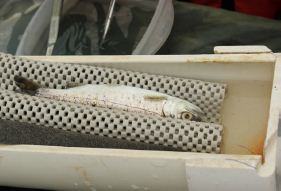Coho Crash TaggingBy NW Indian Fisheries Commission
"We were expecting a relatively healthy run of outgoing coho this spring, somewhere around 55,000 fish," said Scott Steltzner, biologist for the Squaxin Island Tribe. "But, this year, the run is looking to be around just a third of that. More troubling, the fish are coming out smaller than we'd expect." Because of the low run and small fish the tribe is having a hard time finding candidates for an acoustic tagging project now in its second year. The tribe is borrowing 25 juvenile hatchery coho from the state's nearby Minter Creek hatchery to tag and release into Goldsborough Creek. Tiny transmitters implanted into juvenile coho allow researchers to track the young fish as they make their way out to saltwater. "We've used this technology to track coho across deep South Sound, but now we're taking a closer look at Shelton Harbor," Steltzner said. An array of acoustic receivers located along the creek, in Shelton Harbor and all the way out to the Pacific Ocean will track the fish as they begin their migration. Each tagged coho's individual sonic frequency is picked up when it passes by a receiver and its movements are tracked for several hundred yards. This year's low run is in strong contrast to a recent trend of increasing coho runs in Goldsborough Creek in the aftermath of a dam removal ten years ago. "We've seen steadily increasing runs since salmon were able to access almost 25 miles of new habitat in the upper watershed," Steltzner said. "In fact, we expected this year to be one of the largest coho years since the dam came down." The coho crash in Goldsborough likely has something to do with a regional decline in coho returns over the past two years. Throughout southern Puget Sound coho returns the last two falls have been much smaller than predicted. "Goldsborough had been a stand-out for coho, showing strong returns even while other creeks have been in decline," Steltzner said. "It looks like there's a drastic regional decline in coho that's impacting even relatively healthy creeks like Goldsborough." Fittingly, the tribe's acoustic research could point to solutions to the regional coho crash. "We're looking for how salmon are surviving in saltwater," Steltzner said. "If the reason for the lack of coho can't be found in the freshwater environment, seeing how they're doing farther out in Puget Sound could provide some clues."
Back to Home page. |

 Because of an unexpectedly low number of young coho leaving Goldsborough Creek this spring, the Squaxin Island Tribe is borrowing some hatchery salmon to carry on a research project.
Because of an unexpectedly low number of young coho leaving Goldsborough Creek this spring, the Squaxin Island Tribe is borrowing some hatchery salmon to carry on a research project.